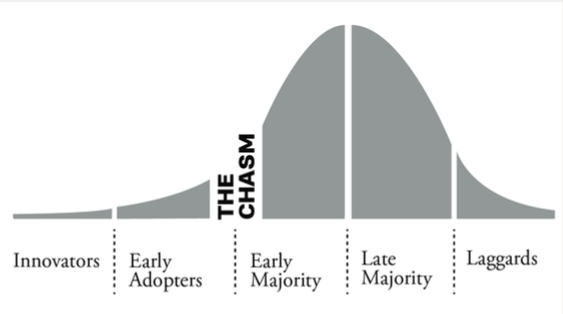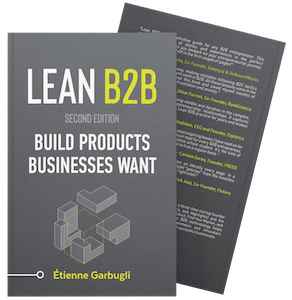Steve Jobs famously said that people don’t know what they want until you show it to them. But, if no one knew what they wanted until others started using it, how would new solutions get traction in the first place?
In 1962, Everett Rogers, a professor of rural sociology published Diffusion of Innovations. The book introduced a theory that explains how, why, and at what rate new ideas and technologies gain adoption in the market. Along with the theory, Rogers introduced the five categories of adopters of new technologies—Innovators, Early adopters, Early majority, Late majority, and Laggards.
While Steve Jobs was right in saying that most customers won’t know what they want until it has become popular, two of these groups will.
Early adopters know what they’re looking for. They can see value in nascent technologies, and imagine new benefits from products that aren’t fully formed, if those products can help them achieve their goals.
While they may not always have the budget to become true customers, the inputs and influence of early adopters can help open the doors of large companies for our innovations.

What Are Early Adopters
B2B Early adopters pursue new products for their intrinsic benefits. They know what they are trying to achieve, and have a good idea of what they’re looking for. They can often see the added benefits of new products, sometimes even before the creators have fully understood the potential.
They also have the potential to help you find product opportunities in the enterprise. This is why this group needs to be your first target.
As leaders, early adopters have a great understanding of the technology landscape both inside and outside of their company. They also have a higher tolerance for risk and a greater ability to see the potential of new technology than most of their colleagues.
Find Early Advocates for your Business – Get the Evaluation Grid (Free)
They’re not always easy to identify. There are tactics that can help us founders know how to identify early adopters.
How to Identify Early Adopters in B2B
We typically recognize early adopters by these traits:
- They’re actively looking for a competitive edge.
- They have the ability to find new uses for a technology.
- They’re often intrapreneurs, or at least change agents.
- They exert some sort of technological leadership in their companies (although they might not be in a leadership position).
- They have a greater tolerance to risk than most of their colleagues.
- They will use a product that isn’t complete.
- They want to be seen as problem solvers, and have an impact improving their companies.
- They are willing to accept partial solutions, if those solutions are improvements over their current solutions.
- They will use a product that isn’t complete.
That last point is particularly relevant for us.
Early adopters are, by definition, early customers of a company, product, or technology that can also be likened to trendsetters. They are not a social club or a personality type.
It’s important to understand that (being an early adopter) it’s not a personality type, so we get lost, especially in the tech scene, people assume that ‘people who are early adopters and get the new iPhones are the same people that go and try the new coffee shop’ and that’s not true. – Brant Cooper, Lean Entrepreneur Author and Entrepreneur
There is no bar where they hang out to talk about new technology adoption; it’s not that easy. Early adopters are problem and opportunity specific. They’re the people who are looking for an edge in their work.
Being an early adopter of Human Resources (HR) software doesn’t make you line up to buy the latest iPhone on the day of its release.
The early adopters you seek will be uniquely related to the Job or opportunity that you address. They’ll be the stakeholders trying to get the Job done faster, more conveniently, or with better results.
How to Find Early Adopters
The best way to find internal champions is through your network, no further than one link away (i.e., friends of friends). – Steve Blank, The Four Steps to the Epiphany Author
One of your biggest challenges early on will be to find early adopters to speak with.
The best way to find early adopters is to start with the people you know, through your personal network at one degree of separation.
Your professional network will be a crucial driver of your success. Do you have contacts in your network that fit the profile of early adopters in your industry?
Take the time to go through all of your contact lists (email, mobile, LinkedIn, Facebook, Twitter, etc.). Make a list of every project you’ve ever worked on and everyone you’ve worked with. Draft a list of potential early adopters working in your target market.
Do the same for your contacts’ professional networks using a tool like LinkedIn. Are there people your first-degree connections could introduce you to?
You start with the people you know and the people you can get recommended to as friends or close acquaintances.
If you have close contacts with extensive professional networks, you can ask them to refer people that match your ideal customer profile, but it’s generally best to keep the initiative.
Find Early Advocates for your Business – Get the Evaluation Grid (Free)
How to Get Early Adopters From Your Professional Network
“Here’s what we’re doing; do you know anybody who fits this profile?”
Accountants, headhunters, investors, recruiters and lawyers are notorious for having large business networks. Perhaps some of your partners or other startup founders can help identify a few early adopters to add to your list.
“Who are the most innovative companies or people in this industry?”
After going through your contacts’ professional networks, you should start to have a good list of potential early adopters for your target market.
Start there. These will be the easiest to motivate to work with you.
To expand your list from there, you’ll be able to use our guide to find early adopters in the market.
More on How to Identify Early Adopters in B2B
- The Early Adopter Profile – Why the Original Definition Still Matters in B2B
- How to Find Early Adopters in B2B – The Complete Guide
- How to Find Early Advocates for Your B2B Startup
Download the First 4 Chapters Free
Learn the major differences between B2B and B2C customer development, how to think about business ideas, and how to assess a venture’s risk in this 70-page sampler.
Working on a B2B Startup?
Learn B2B customer development with our free email course:


